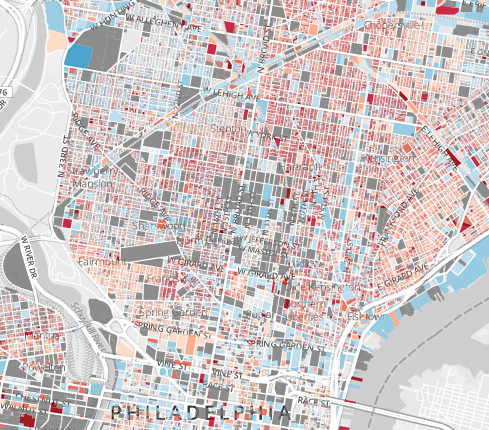
As the City of Philadelphia is sending out mailed paperwork to property owners alerting them to the new, massive overhaul of city real estate value assessments, an API of the data and a web app has already launched. The process to get that done just might mark a watershed in workflow for city data to be released.
Visit the AVI Calculator here.
See the API of the data here.
Use an Axis Philly app to visualize the change in values here.
More than 10,000 queries were put to the tool over the weekend launch.
Using the web app, users can see the existing real estate assessments of any property in the city, in addition to the updated assessments for 2014, which will soon be taxed on an average millage rate between 1.2 and 1.4 percent, depending on ongoing legislation.
The effort to modernize the city’s property tax system is among the most wide-ranging efforts of the Nutter administration, but consider for a moment the process by which the data was released.
- The City’s Office of Property Assessment managed a citywide effort to assess the $96.5 billion in city real estate.
- City Managing Director Rich Negrin and Chief Innovation Officer Adel Ebeid offered political cover and legal support for the fast-tracked release of the app and data, in addition to standard paper-based alerts to property owners.
- City Chief Data Officer Mark Headd managed the relationship between executives and IT and obtained the data source from the Office of Property Assessment, with the Finance Department.
- City GIS specialists David Walk and Sarah Cordivano cleaned the data for accuracy and consistency and then built the API.
- City Director of Civic Technology Tim Wisniewski built the web app interface.
Just two years ago, this process was nearly impossible: the OPA had only just begun to replace the beleaguered Board of Revision of Taxes; there was not yet much top-level interest in civic accessible IT, as former city CIO Allan Frank was sparring with Negrin; no Open Data Executive Order, no legitimacy through Headd or front-end specialists like Wisniewski.
Property taxes affect a wider swath of Philadelphians than almost any other data set. The necessity to offer bold transparency for such a change offered all the motivation.
So credit is due for what could be the beginning of a real pipeline for seismic movement in web access, but this is surely closer to the beginning than the end. In 2011, Technically Philly widely reported that workflow, not political pushback, was the greatest hindrance to open data releases. Today, police detectives still must use typewriters to write search warrants, so work is left to be done.
But if web-based transparency and efficiency will come fully to City Hall, the process just might look a lot like this.







